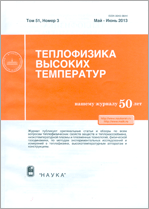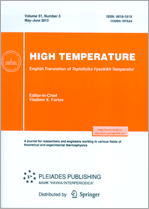|
|
Teplofizika vysokikh temperatur, 2015, Volume 53, Issue 1, paper published in the English version journal
(Mi tvt7941)
|
|
|
|
This article is cited in 6 scientific papers (total in 6 papers)
Papers published in the English version of the journal
Heat and Mass Transfer and Physical Gasdynamics
Enhancement of natural convection heat transfer using different nanoparticles in an inclined semi-annular enclosure partially heated from above
S. Bezi, N. Ben-Cheikh, B. Ben-Beya, L. Taeb
Laboratory of Fluid Dynamics, Physics Department, Faculty of Sciences of Tunis, 2092 El-Manar II, Tunisia
Abstract:
This study addresses a numerical analysis of heat transfer and fluid flow in an inclined half-annulus partially heated from above and filled with nanofluids. The conservation equations in cylindrical coordinates are solved using an inhouse FORTRAN code based on the finite volume method coupled with multigrid acceleration. A localized heat source owing constant temperature is placed along the outer cylinder of the annular region. Water-based nanofluid containing various volume fractions of $\text{Au}$, $\text{Cu}$, $\text{CuO}$ and $\text{Al}_2\text{O}_3$ nanoparticles is used to examine potential heat transfer enhancement in the annulus. The effective thermal conductivity and viscosity of nanofluid are calculated using the Maxwell–Garnetts (MG) and Brinkman models, respectively. Different configurations are considered and numerical simulations were performed for different governing parameters such as the Rayleigh number, the size $\gamma$ and/or location $\theta_p$ of the heat source and inclination angle of enclosure $\alpha$. It is found that the average Nusselt number exhibits an increasing trend as dual functions of the Rayleigh number and the solid volume fraction of the nanoparticles. The highest values of enhancement are obtained when using $\text{Au}$ nanoparticles. Moreover, it is observed that the size, $\gamma$, and location, $\theta_p$, of the heater source significantly affect the resulting convective flow. An optimum size of the heater source is manifested in which the average Nusselt number attains a minimum for a given Rayleigh number. Reliable correlations formulae expressing the average Nusselt number in terms of $\text{Ra}$, $\phi$, $\gamma$ and $\theta_p$ are established. Also for $\gamma = 180^{\circ}$, we note that the change of inclination angle has a significant impact on the thermal and hydrodynamic flow field. It is shown that the minimum values of average Nusselt numbers are found to be at $\alpha_{min} = 45^{\circ}$, $90^{\circ}$, $90^{\circ}$ for $\text{Ra} = 10^3$, $10^4$ and $10^5$, respectively. However, its maximum occurs at $\alpha_{max} = 180^{\circ}$ for all $\text{Ra}$ number.
Received: 08.10.2013
Linking options:
https://www.mathnet.ru/eng/tvt7941
|


| Statistics & downloads: |
| Abstract page: | 13 |
|





 Contact us:
Contact us: Terms of Use
Terms of Use
 Registration to the website
Registration to the website Logotypes
Logotypes







